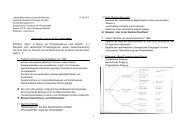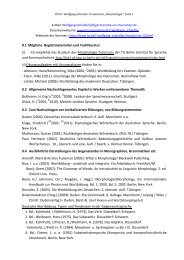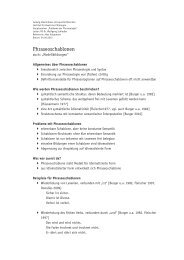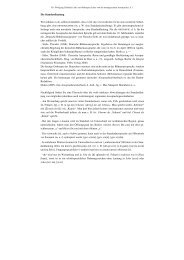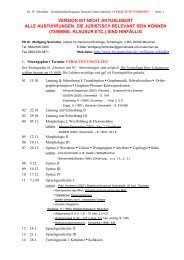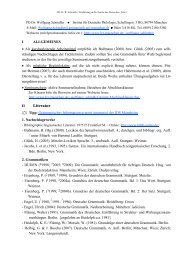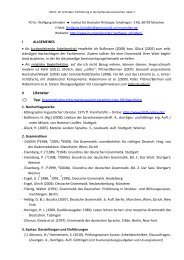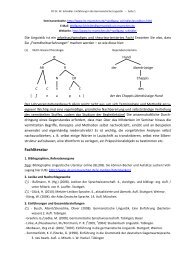Chapter 18 Lexical Functions: Description of Lexical Relations in a ...
Chapter 18 Lexical Functions: Description of Lexical Relations in a ...
Chapter 18 Lexical Functions: Description of Lexical Relations in a ...
You also want an ePaper? Increase the reach of your titles
YUMPU automatically turns print PDFs into web optimized ePapers that Google loves.
—<strong>Chapter</strong> <strong>18</strong>. <strong>Lexical</strong> <strong>Functions</strong>— 30<br />
Thus, the LF Syn does not represent a purely semantic relation: it stands for a LEXICAL relation, <strong>in</strong><br />
the same ve<strong>in</strong> as Anti and Conv.<br />
2. Anti [Lat. antonymum] = antonym<br />
This LF corresponds to the second important relation dealt with <strong>in</strong> MTT: roughly speak<strong>in</strong>g,<br />
that between X and not X, i.e., between an expression and its negation. Anti applies to any LU L<br />
whose mean<strong>in</strong>g (L) conta<strong>in</strong>s <strong>in</strong>side a functor which accepts the negation, i.e., (L) admits a nega-<br />
tion; Anti returns for L an LU L´ such that the mean<strong>in</strong>gs (L) and (L´) differ only by a negation <strong>in</strong><br />
one <strong>of</strong> them. Anti does not have its own part <strong>of</strong> speech, but L can be <strong>of</strong> any part <strong>of</strong> speech, and<br />
Anti takes on the part <strong>of</strong> speech <strong>of</strong> L.<br />
The negation that dist<strong>in</strong>guishes an LU L1 and its antonym L2 can be positioned at different<br />
depth with<strong>in</strong> the mean<strong>in</strong>g (= semantic decomposition) <strong>of</strong> (L2), and this leads to four major types<br />
<strong>of</strong> antonyms—especially s<strong>in</strong>ce they behave differently under paraphras<strong>in</strong>g (Apresjan 1974: 288-<br />
302, Apresjan & C<strong>in</strong>man 2002: 112-116 and Milićević 2003a: 195ff): contradictory Anti - ,<br />
contrary Anti neg, <strong>in</strong>verse Anti > and opposed Anti opp.<br />
1) Anti - is a contradictory antonym (<strong>of</strong> L1)—with an ‘<strong>in</strong>ternal’ negation, that is, a<br />
negation that bears on a semantic component WITHIN (L1):<br />
if L2 = Anti - (L1), then (L2) = (L´1 ... not L´´1).<br />
This type <strong>of</strong> antonym corresponds to the mathematical m<strong>in</strong>us <strong>in</strong> negative numbers; hence the<br />
notation.<br />
Examples<br />
openV Y = (cause that Y becomes open),<br />
and Anti - (openV) = closeV ≡ (cause that Y becomes not open)<br />
allow Y to Z = (say that Y may do Z),<br />
and Anti - (allow) = forbid ≡ (say that Y may not do Z)<br />
Contradictory antonyms Anti - <strong>of</strong>ten form triplets <strong>in</strong> which an Anti - (L) contrasts with a<br />
negation <strong>of</strong> L:<br />
L Anti - (L) negation <strong>of</strong> L<br />
X likes Y ~ X dislikes/hates Y ~ X does not like Y<br />
X builds Y ~ X destroys Y ~ X does not build Y<br />
X is joyful ~ X is glum/gloomy ~ X is not joyful<br />
Remark<br />
Note an <strong>in</strong>terest<strong>in</strong>g complication: <strong>in</strong> some cases, the negative particle signals an Anti - , so<br />
that He did not allow me to leave means that he forbade me to leave, not that he simply did not



![E-Mail: Wolfgang.Schindler[ätt]germanistik.uni-muenchen.de Web ...](https://img.yumpu.com/51590147/1/184x260/e-mail-wolfgangschindlerattgermanistikuni-muenchende-web-.jpg?quality=85)
